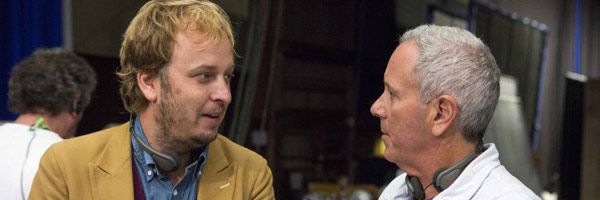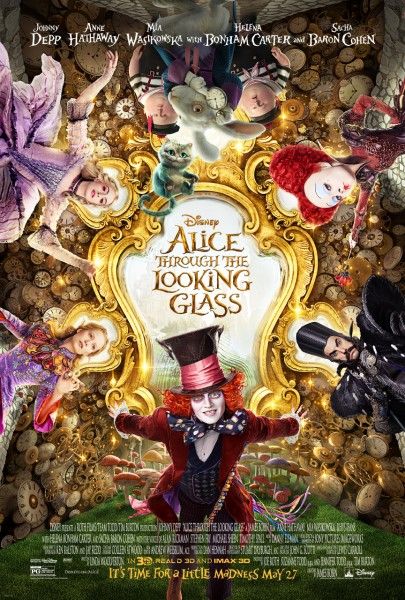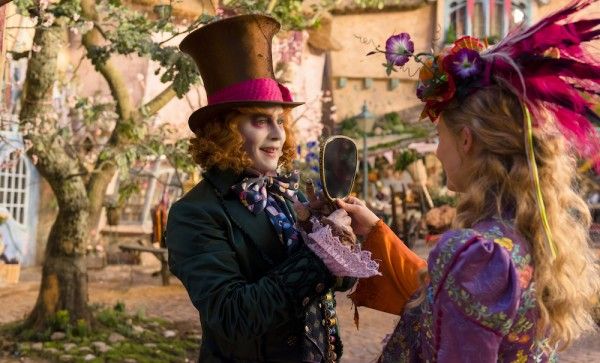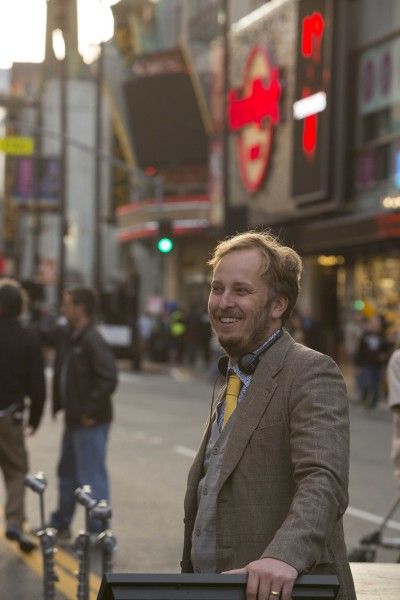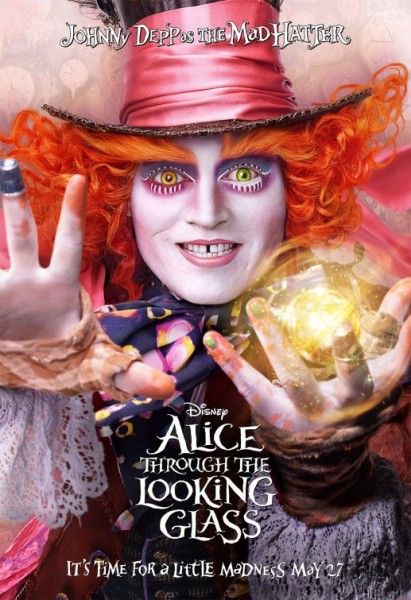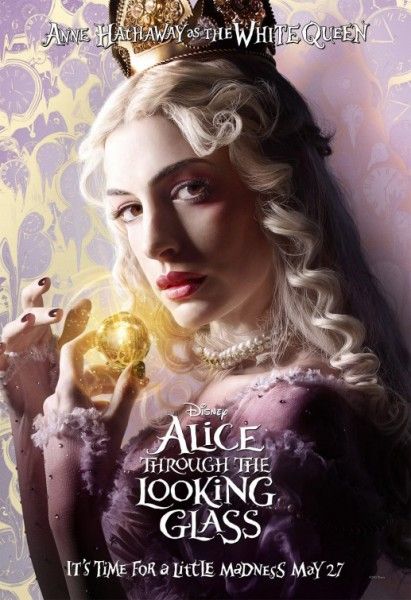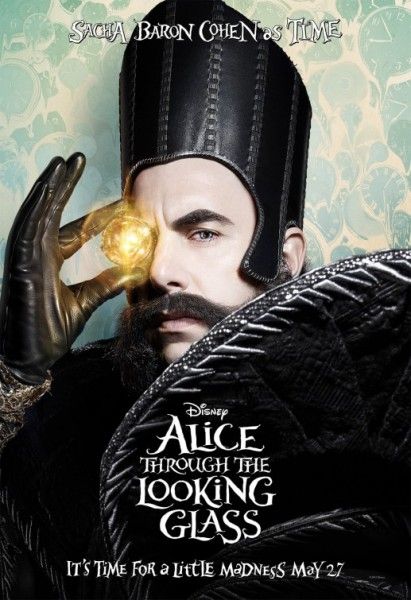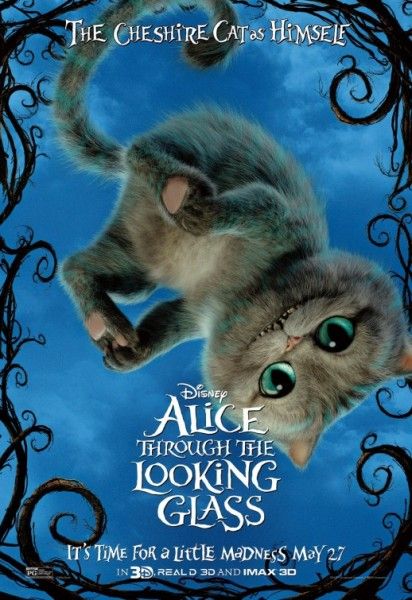Collider was recently invited to screen preview footage for Disney’s upcoming fantasy adventure, Alice Through the Looking Glass, and to chat with the film’s star Mia Wasikowska, director James Bobin, and producer Suzanne Todd. The film is written by Linda Woolverton and produced by Tim Burton, based on Lewis Carroll’s beloved novel, Through the Looking-Glass. In the Alice In Wonderland sequel, Alice (Wasikowska) returns to the whimsical world of Underland and travels back in time to save the Mad Hatter (Johnny Depp). The movie reunites the cast and unforgettable characters from the first film while also introducing exciting new characters played by Sacha Baron Cohen and Rhys Ifans. The plan to release in IMAX 3D seems perfectly suited to the epic scale and immersive nature of this magical story.
Bobin brings his own unique vision to the spectacular world created on screen by Burton for the original, while also introducing his own peculiar comedic sensibility. The footage reveals an entertaining story with an intriguing plot that plays with the concept of time and allows Bobin to more fully explore the geography of the place through time. This marks the first time The Muppets director has worked with fully animated characters in CG environments. There’s also a more human element to it because of the script, so he’s designed and built a lot more practical sets for this film compared to the first one. The sequel, like the original, features interesting character development, strong performances, and impressive production values, including colorfully eccentric visual design and makeup and captivating costumes by Colleen Atwood.
The clips we were shown of the unfinished film are missing special effects and other final touches. They were introduced by Bobin and Todd, as follows:
- Clip #1 is the film’s opening action sequence. Alice, now a ship’s captain, returns to London at the helm of her father’s ship following an overseas adventure. She’s matured into an intelligent, resourceful and brave young woman. When pirates suddenly attack, she and her crew are outnumbered and retreat into treacherous waters. Alice refuses to surrender and hatches a daring escape plan, ordering her crew to hoist full sails and set a course through the shoals. She is undaunted when her first officer warns her their ship will capsize. Her strategy pays off and they successfully evade the pirates.
- Clip #2 takes place after Alice returns to London following her transatlantic travels. She discovers a magical looking glass that facilitates her return to the fantastical realm of Underland. Alice falls through the sky and lands in Underland where she’s reunited with her friends the White Rabbit (Michael Sheen), Absolem (Alan Rickman), the Cheshire Cat (Stephen Fry), Mirana (Anne Hathaway), Tweedledee and Tweedledum (Matt Lucas), and Bayard the Bloodhound (Timothy Spall). She learns from them that the Mad Hatter has lost his Muchness and is not himself. The clip ends with her walking up the path to the Mad Hatter’s house to see what’s become of him.
- Clip #3 opens in the Red Queen’s castle where we’re introduced to a new character, Time (Sacha Baron Cohen), a peculiar creature who is part human, part clock. He’s a villain with the ability to move back and forth through time using a Chromosphere, a metallic globe inside the chamber of the Grand Clock which powers all time and keeps time moving forward. When the tyrannical Queen of Underland (Helena Bonham Carter) pays Time a visit, he tries to placate her by complimenting her on the size of her head and presenting her with a small token of his affection – a miniature guillotine. She dissolves into tears, telling him, “If you really loved me, you’d give me more time,” which he’s reluctant to do. Meanwhile, Alice has been sent by Mirana on a quest to borrow the Chromosphere and save the Mad Hatter by turning back the hands of time. Once she succeeds in stealing the Chromosphere, time comes to a sudden halt. When Time realizes what’s happened, he panics.
- Clip #4 opens with Time traveling back in time in search of Alice. He flies into Underland in an odd-looking contraption that crash lands next to the Mad Hatter’s Tea Party. He asks the Mad Hatter for help in finding Alice. The Mad Hatter suspects what’s at stake and stalls for time. He assures Time that Alice will be coming by later and invites him to join his Tea Party.
At a roundtable interview following the screening, Bobin talked about how the project first came to him, how dealing with CG characters compared to working with The Muppets, what it was like stepping into the world that Burton had created, his appreciation of the tone, the intelligence and the social commentary in Lewis Carroll’s novels, how Alice represents a new generation of women who are not prepared to accept the status quo, the concept of time travel and how Carroll’s work was 30 years ahead of its time, the development of the Chess motif in Victorian fiction, the challenge of creating a tangible Victorian reality that evolved into a weird fantasy world, why he loved constructing practical sets, the inspiration for the character of Time, his creative collaboration with Cohen and Depp, how they broke the camera at Shepperton Studios, and his upcoming project at Sony.
Check it all out in the interview below:
How did this project first emerge?
JAMES BOBIN: (Laughs) Let me cast my mind back. I was at Disney. I was working for Disney, and I was finishing Muppets Most Wanted, and I was talking about other things that they were thinking about getting involved with. They mentioned Alice and I said, “I know Alice very well,” because in England it’s a book that your grandparents have at their house, your parents have at their house, and I have at my house. It’s a thing that everyone knows. You grew up with it. I’ve always loved Alice and I’ve always loved Lewis Carroll. I love his kind of tone and his intelligence. So, it was the chance to work on a sequel to Tim’s movie, which I could then bring some of my sensibility to in terms of my comedic background. I’ve always thought that Lewis Carroll himself had a certain comedy tinge to him. He was a guy who was a satirist. He really was a social commentator in many ways and was trying to satirize Victorian society. If you look at English comedy, we’ve always liked satire and surrealism from him to Edward Lear to The Goon Show to Monty Python. There’s a very singular line of that in what we find funny as a nation, and what I find funny, because I’m from there. I felt I could bring some of that to this world in a successful way, and I hope that’s what I’ve done.
How do the CG characters in this movie compare to working with The Muppets?
BOBIN: They’re hugely different. Muppets was very much an exercise in anti-CG and the anti-effects world. It was very much in camera. We wanted to create a world where tangible puppets walked around and talked to each other. You could touch them. You could meet them. This is the other end of the spectrum, and that’s why I liked it, because I wanted to do something completely different. As a director, obviously you should challenge yourself. It’s important, because it’s this thing that takes you away from your family for years. You have to really love the thing you’re doing. It’s very important.
Was this the first time that you did CGI?
BOBIN: Yes. I mean, of any great scale, I’d say. It’s not my first time ever, but yes. It was the first time where I had fully animated characters and then CG environments. I mean, to be fair, I did build quite a lot of sets for this film. One of the differences I think between this one and the last one is that I was very keen to try and build stuff as and when we could, because I’ve always liked building sets and I like actors in sets. This film has a slightly more human element to it because of the script. There are different stories. It has this family who are humans and we come to a village that’s populated by humans. It’s quite influenced by the work of John Tenniel, who is the guy who did the drawings in the book. And that was always a very human world, even though it was a world in which dodos and unicorns and lions co-existed. That felt important to me, whereby it felt like a human world with animals in it.
What is the social commentary in Alice Through the Looking Glass?
BOBIN: That’s a good question and it’s an important question. One of the first things I looked up with Alice was how it was made. I went to the University at Oxford so I knew the river where Carroll told the story to Alice Liddell, the girl who was the real Alice. I was interested in Alice Liddell and where she came from and her life. She was born in the 1850’s. Then, I thought, wait a minute, because that is the same decade that someone like Emmeline Pankhurst was born, who then later on, of course, became the founder of the Suffragette Movement in England for women’s suffrage. So, I thought she really does represent a new generation of women who are not prepared to accept the status quo and think and strongly believe they should be equal to men. This is the first time in history that this has happened. I loved the idea that Lewis Carroll, even in those days, saw this, that there was going to be a change in the world, and that women were no longer going to be like the women he knew or his mother’s generation. They’re going to be more like this young generation that were going to take over the world or try at least to get equality to a degree. I feel like he invested these great traits of intelligence, bravery, and a refusal to accept her place in the world in this character, which then Tim brought through in the first film, and I think is very important for this film. That’s why I made her the ship’s captain. Historically, it probably could never have happened, but I loved the idea of that because it feels like it represents her strength. She’s brave and she’s clever. She’s not a superhero. She’s a woman and that’s great. I love that about her. For me, we have still a long way to go in those equality terms, but any step we can take towards that by using the medium of film I’m very in favor of.
Visually, this was a world Tim created and he has this very specific view of the world. Stepping into this, what was the experience like for you taking what Tim built and expanding on it?
BOBIN: Well, it’s a delicate balance, because obviously I loved the first film in terms of Tim’s work on it. Its look is beautiful. It really is a spectacularly interesting world to live in and the characters are so spectacular – Helena’s look and all that stuff. I really wanted to pay tribute to that, to keep that sense of the universe being whole, but we were lucky in the script that we had that we could move through time. So therefore, I was able to do different things and use different places. We hadn’t really ever fully explored the geography of the place. In my design choices, I was trying to bear in mind the world that Tim created so it felt like I was in the parameters of that world. Yet, at the same time, you could bring again a slightly more human, weird, quasi-historical that felt a real vibe to it so it’s not quite as fantastical. The trees are more real and the play people because there are humans in it. I felt we wanted to bring it slightly more into the Victorian realm, into more of the John Tenniel realm. But, at the same time, make sure it didn’t feel like a completely different movie. It should feel like it’s the same world, because it really is. It’s a continuation of the story from the first film. The story is what happens next and what happened before. It’s both a prequel and a sequel. But it is, and that’s what’s great about it. We have done a story which is not Lewis Carroll’s story, but that’s because the Looking-Glass book is a very unusual book. Charles Dodgson (Lewis Carroll) was really a mathematician, and he always, for himself, would try and make it interesting. He liked patterns and language. And so, for the book, it’s eight chapters, which is an allegory of a chess match, because obviously the chessboard has eight squares in either direction. In the book, Alice becomes a Queen. And obviously, if you play chess, and you move a Pawn across the board eight moves, then you become a Queen. This was the sort of thing he liked playing with. That’s great for mathematicians, but not great for storytelling, because it means the book itself, whilst being hugely interesting, doesn’t have any real cause or effect or any kind of sense of narrative drive, so to speak. So, I was very keen that when Linda worked on it that we could have a story which took the characters we liked from the first film and used the grammar and the language and the tone and the world of Looking-Glass without having the narrative Looking-Glass.
Did you take any elements of the book?
BOBIN: Yes, but more, as I’m saying, in terms of design, of location, of ideas, of grammar, of just the sense of the place, rather than actual narrative drive. Like there’s no sheep in the shop like in the book. In the book, lots of things happen to Alice, and then the world just falls apart around her, and it’s a bit odd for a film. It’s fascinating, and it’d be a very interesting art house experiment, but I didn’t want to do it with this film, because I wanted to make a film that my daughter, who is eight, would really love. She likes story more than anything else. The story in Alice Through the Looking-Glass is interesting, but not one that really suits the film as such really, I don’t think. So, it was really a question of trying to create a sense of space. The other point about that was that, of course, most people don’t know the difference between Alice in Wonderland and Alice Through the Looking-Glass. Most people have read the original version or seen the 1957 animated feature or Tim’s movie, which often is an amalgam of both books. For example, the Tweedledum and Tweedledee are not in Wonderland. They are in Looking-Glass only. Jabberwocky is only in the second book. Generally, people have mixed the two together. There isn’t that much left once you’ve taken those bits and pieces out. So really, it’s a question of trying to create a narrative using those great characters from before, but in a world which pays tribute to the book in the sense that she goes through the Looking-Glass, because that is such a brilliant idea. Again, it’s that thing with why he was the first person to come up with this incredibly clever concept, and this was before the time of science fiction. I think H.G. Wells is the guy who invented that genre to a degree. Lewis Carroll’s work was 30 years ahead of that. So, he was creating a fantasy world purely from a Victorian mindset. I loved that about it and that’s why I wanted to stay true to the idea.
When Tim Burton was at Comic Con for the first movie, he said that Disney pushed it as a fantasy film. But he said, “For me, it’s a commentary because it’s my kind of world that I explore every day.” What is it for you?
BOBIN: It feels very similar for me. I love the fact that Alice is of that generation, that historically it works, that that is what he was pointing towards, because I’m a historian. I studied history at the university, and I’ve always loved that world, and that’s why it’s a great film experience of creating a tangible Victorian reality in the beginning which then kind of cracks into this weird Victorian fantasy world. I love the idea of different time periods have different ideas of what a fantasy world would be because of what they know of the world themselves. The idea of a Victorian fantasy world is a fascinating one because you think that is limited to a degree because they don’t know about space or time, and time travel itself wasn’t really discussed that much prior to H.G. Wells, to be honest. It’s an interesting world. That’s why. It’s largely based on nursery rhymes. If you look at nursery rhymes in England, they’re very, very, very old, and Lewis Carroll hugely drew on them in terms of his inspiration for the oddities of the world. Those go back to myths, and myths are incredibly ancient and pre-date religion. I love the idea that these are very old stories he’s retelling in very interesting ways, in Victorian ways, and that, to me, is fascinating.
You mentioned that you didn’t want to have only CGI, but you also wanted to have a lot more practical sets in this one than were in the first film. What were the practical sets that you built?
BOBIN: We built the town of Wit’s End, which is a large part of the movie. It’s where the Hatter family have their shop where they sell hats. I wanted to build a set because I’ve always liked those films like Oliver and Charlie and the Chocolate Factory in the 1960’s where they had very big sets of a certain scale. I liked the fact that actors could interact in that world. I felt that you can always put CG on the edges of that world and build it up into the thing you need to make scale-wise. But, for intimate moments and scenes where you’re just in a room, I love the idea of being in a room for real, because it feels like for actors you have a sense of place, which is important in the sense just in simple terms of blocking. I mean, blocking in a blue screen room is fine, but it’s much more fun to do in a real room, because then you’ll see your challenge. In a real room, you can fly balls out and change camera positions, but you are to a certain degree limited, and that limitation is to your advantage because it helps to make creative choices. Somehow, in a blue environment, as Lars von Trier knows in his Dogma films, they are very open, and you have too much choice sometimes and then you get lost. So, it’s good to have a discipline within that room, because every choice is available because of the geography. I’ve always liked sets. I think they’re fascinating. I’ve always loved the experience of being on them and hopefully that translates to the screen.
When you were doing The Muppets, you could hug Kermit, but now you have so many CGI characters.
BOBIN: I know, and that’s very sad. It’s true. I’d love to hug the Cheshire Cat. He’s so beautiful, and he’s very furry and sweet. And then, in this film, we go right back to when they were kids basically, and they are very, very sweet in that point, and my daughter would love to have hugged the Cheshire Cat when he was a baby. But sadly, he doesn’t exist anywhere apart from in zeroes and ones on a computer somewhere.
If you could have a character for yourself in real life, which one would you take?
BOBIN: I would take Thackery. I love Thackery because he’s crazy, and so, he’s a very amusing character. And again, he’s got very nice fur. He’s very soft.
Can you talk about the new character, Time? The way he speaks reminds me of the book. Was it a challenge to create him?
BOBIN: When I first came on the film, I had an idea about it. The script had time travel in it already, but I liked the idea of Time being a character. It was really a thing I remembered from reading the first Alice in Wonderland book. When Hatter first meets Alice, what he said in the book was, “I’ve been stuck at this Tea Party since last March when Time and I quarreled.” So, Lewis Carroll had the idea for Time. In Lewis Carroll’s brain, Time was a person. I thought that is a brilliant idea for an antagonist in this world. So I said, why don’t we have a guy who is the personification of Time, who Alice is going to have to go and ask permission of to borrow the machine to travel through time, because obviously it’s very English to go, “Please may I borrow something to do something?” It was a great character, I felt. Then, once you have that element to it, you think, well I don’t want him to be just one straight out bad guy. So, bearing in mind the idea of bringing some sort of comedy or satire to that world, then I thought it would be interesting to have someone I knew and could trust to be a kind of confident idiot. And, of course, Sacha Baron Cohen might bring that effect, because there is no one better as a confident idiot than Sacha Baron Cohen. I wanted the character to be powerful, but not too powerful, to be vulnerable, to be kind of a lonely despot, and that’s what he became. The voice was really a thing. Again, I’ve worked with Sacha Baron Cohen on many characters. We were in Borat together. We made Da Ali G. So, this was just another thing where I was sort of in this central European area. Switzerland, of course, was a new possibility, but I’ve always liked the precision of German, and German I felt would be very interesting, but not the obvious German. There’s a very obvious German which you’ve seen a half a thousand times before. So I said, “Try and think of interesting,” and he actually came up with the idea of the character in terms of what he is. It’s kind of Mid-Atlantic German and it sounds like a very famous documentary filmmaker to my ears. I liked that about it, too, because it lends character, and it instantly makes it funny, because he himself has a very precise pattern to his language, and Lewis Carroll is a man who sets with pounds of language. So, I hope he would have liked the fact that his character was like that.
In the first movie, Johnny Depp played the crazy character.
BOBIN: Yes. He’s now got a friend.
Now you have two crazy characters. Was there any competition going on between those guys?
BOBIN: Oh, a little. Always, of course. But no, I think Johnny, in this one, also knew that his character was kind of the jeopardy or the stake. His survival was the jeopardy of the movie. What I loved about Johnny’s portrayal of the character in the film was his vulnerability. Johnny’s very good at doing that. The character obviously is mad, and not in a boring way, but in an interesting way. But, at the same time, he’s very good at playing vulnerable. And that’s how amazing it is for a mad person to be vulnerable. It’s good because it’s true. I felt that would be a great drive for this film if you felt the guy that you loved is kind of falling apart. It would be a very good drive, not only for Alice, but for us, because we see the movie through Alice’s eyes. Again, you didn’t have to see the first one, but you know the Hatter is such a fun character that his potential demise would be a very good engine for the movie. At the same time, of course, we get to visit him in the past at which point he can be his natural fun self again.
We did have several scenes with Sacha and he, which just go on forever. It was fun because they’re friends. There’s the scene you saw this morning, the Hatter scene at the Tea Party, and you can imagine how that went. It was a very hot day in England on the stage at Shepperton, and Shepperton does not have air conditioning because it’s English, and why would you need that in England? And so, we have a thousand lights upstairs, and the perms are hitting 100-150 degrees, and it’s very, very hot on stage. In one take, they talked and talked and talked for about 8-1/2 minutes at which point I saw the camera basically melt. It just gave up. The camera packed up. It broke the camera. It just started to power down, and I had to call it and say, “You have to stop, because you’ve broken the camera.” They had a fun time doing it. And to be fair, it gives it great energy, and you use some of that stuff sometimes in terms of reactions or little moments. They make a lot of funny noises, the two of them. They’re very interesting in the noises they make together. It was really fun and they had a great time. I think it’s nice for Johnny to have somebody else to play with.
How do you see Johnny? Does he seem more like a comedian now or a dramatic actor?
BOBIN: Well, it’s an unbelievable range he has, because he can really bring it in terms of emotion. In that first scene with him and Alice, you really feel his desperation for Alice to believe him that his family is alive. And that’s what’s so important for the film, because as I said, it’s the engine of the movie. He plays that beautifully. Then, at the same time, he can muck around with Sacha very ably, and Sacha is one of the world’s greatest improvisers. So, to keep up with him is a brilliant talent, too. I mean, Johnny really can do anything. He’s so fantastically likeable. He really is, and that’s what’s so great about his character is that you really root for him and you really want him to get by. Then, when he gets back to himself, it’s even better. So no, I think he really can do anything. It’s an amazing thing. It’s one of the things that you always hope to work with people of his caliber and working with him was an incredible experience.
What are you working on next?
BOBIN: (laughs) My next film (23 Jump Street) is probably going to be something at Sony.
Presented in Digital 3D, Real D 3D and IMAX 3D, Disney’s Alice Through the Looking Glass opens in U.S. theaters on May 27, 2016.

